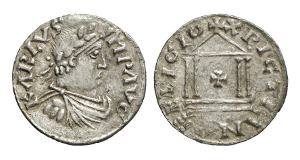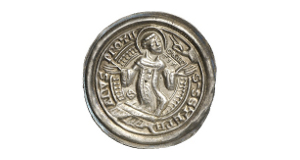Medieval Coins (ca. 500-1500)
The Middle Ages encompass 1,000 years of European history, from the earliest coin mintings of the Germanic successor states to the Roman Empire during the “barbarian” Great Migration period, to the coins of the Emperor Maximilian I (1486-1519), the “Last Knight”.

Porträtdenar Karls des Großen. Zuschlag: 160.000 Euro.
The Middles Ages offer an opening to a great number of fascinating collection areas, with interesting coinages from a time in which the foundation of the modern European minting and monetary system was laid. In addition, coins from a wide swath of medieval history often establish the only source of written records and images which report “at first hand” on events such as changes of rulers, wars, and weddings.

Sizilien. Friedrich II., 1197-1250. Augustalis nach 1231, Brindisi. Zuschlag: 30.000 Euro.
With the coinage reform which he carried out in 800, Charlemagne (768-814) reorganized the Frankish monetary policy of the Great Migration period and created a new system which would, by and large, remain in effect -- in its essential aspects -- for the next 500 years: the only denomination in the currency became the silver denarius, which was to be the 240th part of one pfund (around 400 g). These coins were minted in much of Europe (Germany = pfennig, England = penny, France = denier and Italy = denaro) in a variety of types. In the Staufer period (12th and 13th century) the denarius was minted in central Germany as a large one-sided hollow penny (brakteat) in a highly artistic quality with, in some cases, impressive coin images. The award of minting rights for coins by medieval rulers to clerical (bishoprics and monasteries) and secular (duchies and counties) institutions led, particularly in territories of the German Empire, to a large number of mints (at some points more than 400). The collector of medieval coins thus gains access to numerous subject areas.

Deutsches Reich / Halberstadt. Bischof Ulrich von Reinstein, 1149-1160. Zuschlag: 2.000 Euro.
In the 13th century, gold returned to the mints of the Middle Ages. In the Italian “trade republics” of Florence, Genoa and Venice, due to the demand for larger currencies, the denominations florin, genovino and ducat (orig. “zecchino”) emerged. Together with larger silver coin types like the groat or groschen (Fr. “gros tournois”) these denominations also reached northern Europe in the Middle Ages, where they were imitated in the periods which followed. There emerged differentiated currency systems with a great diversity of currencies, types and coins.
Immerse yourself in the ever-changing coin images of the Middle Ages in the time of Charlemagne (768-814), the Spanish Reconquista (711-1492), the Emperor Friedrich Barbarossa (1152-1190), and the Hundred Years’ War between England and France (1337-1453)!
Start your collection of medieval coins today!
Introductory literature:
- Berger, F.: Die mittelalterlichen Brakteaten im Kestner-Museum Hannover, 2 Bände, Hannover 1993 und 1996.
- Corpus Nummorum Austriacorum, Band I: Mittelalter, Wien 1994.
- Grierson, P.: Münzen des Mittelalters, München 1976.
- Kluge, B.: Numismatik des Mittelalters. Handbuch und Thesaurus Nummorum Medii Aevi, Berlin / Wien 2007.
- Spufford, P.: Money and its use in Medieval Europe, Cambridge 1989.
- Suhle, A.: Deutsche Münz- und Geldgeschichte von den Anfängen bis zum 15. Jahrhundert, Berlin 1975.

